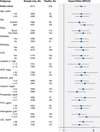Fibroblast growth factor 23 and risks of mortality and end-stage renal disease in patients with chronic kidney disease
- PMID: 21673295
- PMCID: PMC3124770
- DOI: 10.1001/jama.2011.826
Fibroblast growth factor 23 and risks of mortality and end-stage renal disease in patients with chronic kidney disease
Abstract
Context: A high level of the phosphate-regulating hormone fibroblast growth factor 23 (FGF-23) is associated with mortality in patients with end-stage renal disease, but little is known about its relationship with adverse outcomes in the much larger population of patients with earlier stages of chronic kidney disease.
Objective: To evaluate FGF-23 as a risk factor for adverse outcomes in patients with chronic kidney disease.
Design, setting, and participants: A prospective study of 3879 participants with chronic kidney disease stages 2 through 4 who enrolled in the Chronic Renal Insufficiency Cohort between June 2003 and September 2008.
Main outcome measures: All-cause mortality and end-stage renal disease.
Results: At study enrollment, the mean (SD) estimated glomerular filtration rate (GFR) was 42.8 (13.5) mL/min/1.73 m(2), and the median FGF-23 level was 145.5 RU/mL (interquartile range [IQR], 96-239 reference unit [RU]/mL). During a median follow-up of 3.5 years (IQR, 2.5-4.4 years), 266 participants died (20.3/1000 person-years) and 410 reached end-stage renal disease (33.0/1000 person-years). In adjusted analyses, higher levels of FGF-23 were independently associated with a greater risk of death (hazard ratio [HR], per SD of natural log-transformed FGF-23, 1.5; 95% confidence interval [CI], 1.3-1.7). Mortality risk increased by quartile of FGF-23: the HR was 1.3 (95% CI, 0.8-2.2) for the second quartile, 2.0 (95% CI, 1.2-3.3) for the third quartile, and 3.0 (95% CI, 1.8-5.1) for the fourth quartile. Elevated fibroblast growth factor 23 was independently associated with significantly higher risk of end-stage renal disease among participants with an estimated GFR between 30 and 44 mL/min/1.73 m(2) (HR, 1.3 per SD of FGF-23 natural log-transformed FGF-23; 95% CI, 1.04-1.6) and 45 mL/min/1.73 m(2) or higher (HR, 1.7; 95% CI, 1.1-2.4), but not less than 30 mL/min/1.73 m(2).
Conclusion: Elevated FGF-23 is an independent risk factor for end-stage renal disease in patients with relatively preserved kidney function and for mortality across the spectrum of chronic kidney disease.
Figures



Comment in
-
Fibroblast growth factor 23 and CKD prognosis.Am J Kidney Dis. 2012 May;59(5):607-10. doi: 10.1053/j.ajkd.2011.11.017. Epub 2011 Dec 7. Am J Kidney Dis. 2012. PMID: 22153824 No abstract available.
References
-
- Wolf M. Forging forward with 10 burning questions on FGF23 in kidney disease. J Am Soc Nephrol. 2010;21(9):1427–1435. - PubMed
-
- Kestenbaum B, Sampson JN, Rudser KD, et al. Serum phosphate levels and mortality risk among people with chronic kidney disease. J Am Soc Nephrol. 2005;16(2):520–528. - PubMed
-
- Jean G, Terrat JC, Vanel T, et al. High levels of serum fibroblast growth factor (FGF)-23 are associated with increased mortality in long haemodialysis patients. Nephrol Dial Transplant. 2009;24(9):2792–2796. - PubMed
Publication types
MeSH terms
Substances
Grants and funding
- UL1 RR024989/RR/NCRR NIH HHS/United States
- U01 DK060963/DK/NIDDK NIH HHS/United States
- 5U01DK060984/DK/NIDDK NIH HHS/United States
- UL1RR029879/RR/NCRR NIH HHS/United States
- R01DK077128/DK/NIDDK NIH HHS/United States
- K24 DK062234/DK/NIDDK NIH HHS/United States
- U01 DK060990/DK/NIDDK NIH HHS/United States
- R01 DK077128/DK/NIDDK NIH HHS/United States
- 5U01DK060963/DK/NIDDK NIH HHS/United States
- UL1 RR024134/RR/NCRR NIH HHS/United States
- U01 DK061028/DK/NIDDK NIH HHS/United States
- UL1RR025005/RR/NCRR NIH HHS/United States
- M01RR16500/RR/NCRR NIH HHS/United States
- 5U01DK60980/DK/NIDDK NIH HHS/United States
- R01 DK072231/DK/NIDDK NIH HHS/United States
- UL1 RR025005/RR/NCRR NIH HHS/United States
- U01 DK060984/DK/NIDDK NIH HHS/United States
- U01 DK061021/DK/NIDDK NIH HHS/United States
- U01 DK060980/DK/NIDDK NIH HHS/United States
- 5U01DK060990/DK/NIDDK NIH HHS/United States
- R01 DK076116/DK/NIDDK NIH HHS/United States
- RR05096/RR/NCRR NIH HHS/United States
- UL1 RR024131/RR/NCRR NIH HHS/United States
- R56 DK072231/DK/NIDDK NIH HHS/United States
- 5U01DK060902/DK/NIDDK NIH HHS/United States
- M01 RR005096/RR/NCRR NIH HHS/United States
- M01 RR013987/RR/NCRR NIH HHS/United States
- UL1RR024986/RR/NCRR NIH HHS/United States
- 5U01DK061028/DK/NIDDK NIH HHS/United States
- 5U01DK061021/DK/NIDDK NIH HHS/United States
- R01 DK081374/DK/NIDDK NIH HHS/United States
- UL1RR024989/RR/NCRR NIH HHS/United States
- M01 RR016500/RR/NCRR NIH HHS/United States
- UL1RR024131/RR/NCRR NIH HHS/United States
- U01 DK060902/DK/NIDDK NIH HHS/United States
- UL1RR024134/RR/NCRR NIH HHS/United States
- M01 RR000042/RR/NCRR NIH HHS/United States
- M01RR000042/RR/NCRR NIH HHS/United States
- K23DK087858/DK/NIDDK NIH HHS/United States
- 5U01DK06102/DK/NIDDK NIH HHS/United States
- K23 DK087858/DK/NIDDK NIH HHS/United States
- R01DK081374/DK/NIDDK NIH HHS/United States
- UL1 RR024986/RR/NCRR NIH HHS/United States
- UL1 RR029879/RR/NCRR NIH HHS/United States
LinkOut - more resources
Full Text Sources
Other Literature Sources
Medical
Molecular Biology Databases

